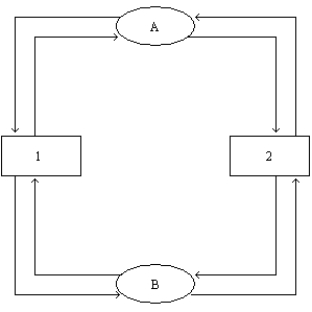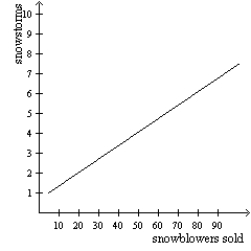A) flows of goods and services from households to firms.
B) flows of inputs from households to firms.
C) flows of rent payments paid to owners of land.
D) flows of wages and salaries paid to workers.
Correct Answer

verified
Correct Answer
verified
Multiple Choice
When economists are trying to help improve the world, they are
A) in the realm of positive economics rather than normative economics.
B) in the realm of macroeconomics rather than microeconomics.
C) scientists.
D) policy advisers.
Correct Answer

verified
Correct Answer
verified
Multiple Choice
In the early 19th century, the Russian government sent doctors to southern Russian villages to provide assistance during a cholera epidemic. The villagers noticed that wherever doctors appeared, people died. Therefore, many doctors were chased away from villages, and some were even killed. This reaction to the correlation between doctors and deaths is most likely a problem of
A) omitted variables.
B) reverse causality.
C) government propaganda.
D) medical incompetence.
Correct Answer

verified
Correct Answer
verified
Multiple Choice
Indiadesh is a country that produces two goods, textiles and computers. Last year, Indiadesh produced 50,000 textiles and 1300 computers. This year it produced 45,000 textiles and 1100 computers. Given no further information, which of the following events could explain this change?
A) Indiadesh decreased unemployment.
B) Indiadesh experienced an improvement in textile-making technology.
C) Indiadesh experienced an improvement in computer-making technology.
D) Indiadesh experienced a reduction in resources.
Correct Answer

verified
Correct Answer
verified
True/False
Historical episodes allow economists to illustrate and evaluate current economic theories.
Correct Answer

verified
Correct Answer
verified
Multiple Choice
The production possibilities frontier is a graph that shows the various combinations of output that an economy can possibly produce given the available factors of production and
A) society's preferences.
B) the available production technology.
C) a fair distribution of the output.
D) the available demand for the output.
Correct Answer

verified
Correct Answer
verified
Multiple Choice
Which of the following statements about the circular-flow diagram is correct?
A) One must imagine that the economy operates without money in order to make sense of the diagram.
B) The diagram leaves out details that are not essential for understanding the economic transactions that occur between households and firms.
C) The government cannot be excluded as a decision maker in a circular-flow diagram.
D) All of the above are correct.
Correct Answer

verified
Correct Answer
verified
True/False
Points inside the production possibilities frontier represent feasible levels of production.
Correct Answer

verified
Correct Answer
verified
Multiple Choice
When income increases the slope of an individual's demand curve, the demand curve
A) turns positive.
B) becomes undefined.
C) remains negative.
D) becomes infinite.
Correct Answer

verified
Correct Answer
verified
Multiple Choice
President Ronald Reagan once joked that a Trivial Pursuit game designed for economists would
A) have no questions but hundreds of answers.
B) have 100 questions and 3,000 answers.
C) have 1,000 questions but no answers.
D) never produce a winner.
Correct Answer

verified
Correct Answer
verified
Short Answer
Use the following Figure to answer the question : Figure 2-3 :  -Refer to Figure 2-3. What do the outer arrows represent in the figure?
-Refer to Figure 2-3. What do the outer arrows represent in the figure?
Correct Answer

verified
Correct Answer
verified
True/False
When a variable that is not named on either axis of a graph changes, we read the change as a movement along the curve.
Correct Answer

verified
Correct Answer
verified
True/False
"Other things equal, an increase in supply causes a decrease in price" is a normative statement, not a positive statement.
Correct Answer

verified
Correct Answer
verified
Multiple Choice
Which of the following statements about models is correct?
A) The more details a model includes, the better the model.
B) Models assume away irrelevant details.
C) Models cannot be used to explain how the economy functions.
D) Models cannot be used to make predictions.
Correct Answer

verified
Correct Answer
verified
Multiple Choice
Which of the following is an example of a normative - as opposed to a positive - statement?
A) The discount rate is the interest rate the Federal Reserve charges banks to borrow funds.
B) The US income tax rate increases with the amount of income earned.
C) The government should increase the tax on gasoline.
D) The US unemployment rate increased to 10 percent in 2009.
Correct Answer

verified
Correct Answer
verified
Multiple Choice
Which of the following is one of the basic reasons why economists often appear to give conflicting advice to policymakers?
A) similar opinions about the validity of economic theories
B) significant differences in education
C) differences in personal values
D) a reliance on normative statement for research theories
Correct Answer

verified
Correct Answer
verified
Multiple Choice
In economics, capital refers to
A) the finances necessary for firms to produce their products.
B) buildings and machines used in the production process.
C) the money households use to purchase firms' output.
D) stocks and bonds.
Correct Answer

verified
Correct Answer
verified
Multiple Choice
Economic models
A) are people who act out the behavior of firms and households so that economists can study this behavior.
B) are usually detailed replications of reality.
C) incorporate simplifying assumptions that often contradict reality, but also help economists better understand reality.
D) are useful to researchers but not to teachers because economic models omit many details of the real-world economy.
Correct Answer

verified
Correct Answer
verified
Multiple Choice
Use the following Figure to answer the question : Figure 2-21 :  -Refer to Figure 2-21. According to the graph, snowstorms
-Refer to Figure 2-21. According to the graph, snowstorms
A) and snowblowers sold are positively correlated.
B) and snowblowers sold are negatively correlated
C) and snowblowers sold are uncorrelated.
D) are caused by more snowblowers being sold.
Correct Answer

verified
Correct Answer
verified
Multiple Choice
Any point on a country's production possibilities frontier represents a combination of two goods that an economy
A) will never be able to produce.
B) can produce using all available resources and technology.
C) can produce using some portion, but not all, of its resources and technology.
D) may be able to produce in the future with more resources and/or superior technology.
Correct Answer

verified
Correct Answer
verified
Showing 561 - 580 of 615
Related Exams